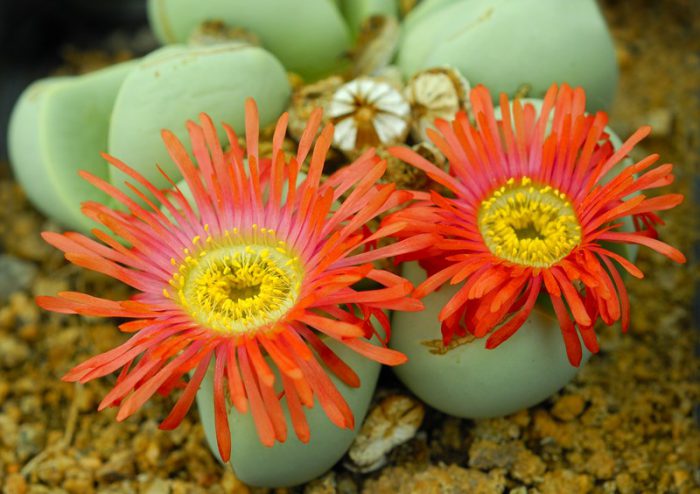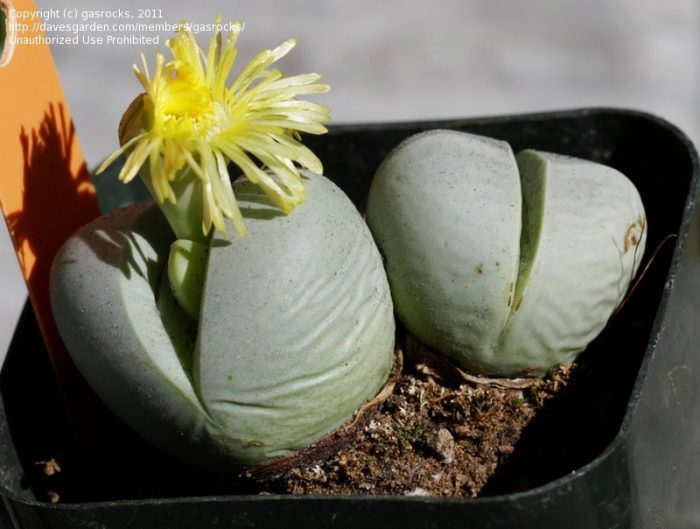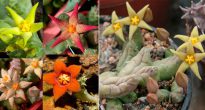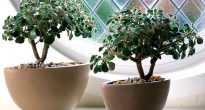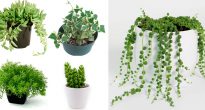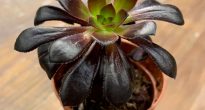Argyroderma (Argyroderma) is a succulent plant that belongs to the Aizoaceae family. These plants come from the Cape Province of Africa, South Africa and the Peruvian desert. They prefer to grow on sandy and rocky ground, while, in order to protect themselves from extreme heat, such plants are able to "bury" in the sand.
This genus of plants was named in this way due to the not quite usual silvery color of its leaves. So, in translation from Latin "argyrum" means "silver", and "derma" - "skin".
Such a dwarf succulent plant is flowering and has an external resemblance to pebbles... Argyroderma is preferred to grow in small groups. The rosette includes 2 or 4 fleshy greenish-gray, half-accrete leaves, which have a semicircular shape. Such leaves face each other with flat surfaces. In most species, the diameter of the leaflets does not exceed 2–3 centimeters, and at the same time there is a relatively deep, clearly pronounced strip, which separates the leaf pair (which is not the case for lithops). Young leaves grow directly between the old ones, which then wither. A short peduncle grows from between the leaf groove. In most cases, the flowers are solitary and have numerous petals. Flowers of three centimeters in diameter can be colored yellow, white or pink and they have a strong external resemblance to daisies. The flowers are bisexual and will require cross-pollination to collect the seeds. Under natural conditions, pollination of such a succulent occurs with the help of insects. Accidental hybridization is not uncommon in culture. In this regard, during the flowering period, various species and varieties need to be somehow separated from each other. Pollination is required to be done independently with a brush.
The fruits ripen for a rather long time, usually until April or March of the next year. The fruits are closed capsules, which have a diameter of about 0.9-1.2 centimeters, and they are formed by accretion of carpels. These capsules are divided into cells, of which there are from 8 to 28 pieces. Ripe cells have a mechanism for the expansion of the keels of the lids when exposed to liquid. So, while it is raining, the lids open, then the falling raindrops easily knock out the ripe seeds, and they, in turn, scatter a not very large distance from the mother plant. When grown indoors, there are 2 ways to collect seeds. First, you can knead the capsules and select the seeds. And secondly, these fruits should be lowered "upside down" into a small container filled with water. After the caps open, the seeds will sink to the bottom.They should be removed from the water and dried in a shaded area.
Content
Argyroderma care at home
Illumination
This plant requires bright lighting throughout the year.
Temperature regime
In summer, the plant grows normally and develops at room temperature. In winter, it needs coolness from 12 to 15 degrees. In this case, be sure to make sure that the room is not colder than 8 degrees.
Humidity
It is quite suitable for living in low humidity of urban apartments.
How to water
Watering is carried out only during intensive growth and flowering. You need to water through the pallet and only after the earthen lump dries completely. Make sure that there is no liquid stagnation in the sump. From about October to April, argyroderma does not need to be watered at all. At this time, the leaves can completely dry out and wrinkle strongly, but watering even in this case cannot be done.
Top dressing
Top dressing should be carried out only during the formation of buds, as well as flowering, while using a weak solution of fertilizer intended for cacti.
Transplant features
The transplant is carried out before the period of intensive growth begins, once every 2 or 3 years. A suitable dredge consists of 2 parts of leafy soil and 1 part of sand. After transplanting, the soil surface is sprinkled with a layer of coarse sand. If you wish, you can buy soil for cacti. The planting container should be low and wide. There must be good drainage holes at its bottom. Also make sure to make a good drainage layer at the bottom of the container.
Reproduction methods
You can propagate it by dividing an overgrown group of plants during the transplantation process, as well as by seeds.
Sowing is recommended in the last weeks of February and the first in March. In this case, additional lighting is not required, and before winter the plant will get strong enough. For sowing, cactus soil is used. On its surface, you need to put seeds and sprinkle them with a thin layer of coarse sand, while the distance between them should be at least half a centimeter. The container must be covered with glass or foil and placed in a warm place (20-25 degrees). During the first month, airing is carried out once a day for 1-2 minutes. Then this procedure is carried out several times a day, and their duration should be from 5 to 10 minutes. 8 weeks after sowing, it is recommended to remove the shelter altogether. Watering is carried out by lowering the pot into a container of water until the soil gets wet. You should choose a brightly lit place, but there should be no direct rays of the sun. The first seedlings will appear about a week after sowing, while the total germination lasts from 30 to 40 days. The flowering of young plants is observed 3 or 4 years after sowing.
Main types
Argyroderma cup-shaped (Argyroderma crateriforme)
In this dwarf succulent in a pair of leaves, the diameter can vary from 1 to 2 centimeters. The fleshy leaves that have grown together at the base are semi-ovate, with the side of the growth flat. The emergence of a flower occurs from between the leaf groove. Outwardly, it is similar to a daisy and has glossy petals of a rich yellow color, whitish stamens, and at the same time its anthers are yellow in color.
Argyroderma ovale (Argyroderma ovale)
Dwarf succulent. The rosettes contain from 2 to 4 juicy cylindrical leaves, which can be painted in various shades from greenish gray to lime green. The flowers are single with a short peduncle and they grow between the upper leaves.The diameter of the flower can vary from 1 to 3 centimeters, and at the same time it can be painted in yellow, white or pink.
Argyroderma testiculare
Dwarf succulent. The diameter of each leaf rosette can reach 2.5–3 centimeters, and they include fleshy leaves that are relatively thick. They face each other with flat surfaces, and can be painted in greenish-blue or grayish-blue. It happens that there are small dots on the surface. A short peduncle grows from between the leaf groove, which bears a flower that looks like a chamomile. Its diameter is about 4 centimeters, and its color is pink. At the end of flowering, old leaves begin to die off, and young ones replace them.

